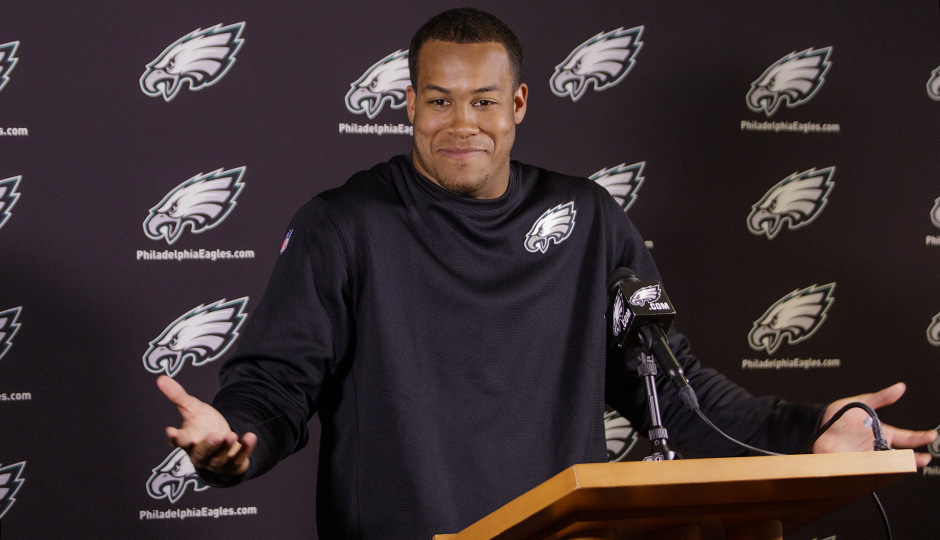Four Downs: Rookies Impress In First Eagles Win

Photo by: Jeff Fusco.
EAST RUTHERFORD, N.J. — The Eagles beat the Jets, 24-17, for their first win of the season. Here’s what we saw.
MOST TELLING STAT: 4
That’s how many times the Jets turned the ball over. The Eagles’ defense played well as a whole, but the rookies stood out as Jordan Hicks and Eric Rowe both recorded interceptions. Hicks also tallied a fumble recovery and double-digit tackles.
Philadelphia was once again stout against the run as New York averaged about three yards per carry. The defensive line not only disrupted plays, but they consumed the offensive line and let linebackers like Hicks make tackles without blockers reaching the second level. Even without Cedric Thornton and Taylor Hart, the defensive line displayed their depth and hardly missed a beat.
The secondary also impressed as the cornerbacks played well in bump-and-run and refused to let receivers create separation. Walter Thurmond joined Hicks and Rowe by intercepting Ryan Fitzpatrick, and Nolan Carroll consistently had great technique on deep routes.
DID YOU NOTICE?
Ryan Mathews combined for more than 125 rushing and receiving yards, but don’t give the offensive line too much credit. Although they did a great job in pass protection and consistently gave Sam Bradford a good pocket to throw from, the same can’t be said for their run blocking.
Mathews consistently broke tackles—sometimes behind the line of scrimmage—and rarely let the first defender bring him down. The offensive line opened up respectable running lanes for him a few times, but they also lost a lot at the point of attack and got little movement on the Jets defensive line.
Mathews was a threat through the air, but he did drop a ball that could’ve led to a big play (more on this later). He also hauled in a 23-yard touchdown catch, but lost a fumble in the fourth quarter. Overall, he played well by picking up more than 100 rushing yards, despite the little space he had to work with.
QB TRACKER
Outside of his touchdown pass to Mathews, Bradford played poorly. He was consistently inaccurate and rarely hit his receivers in stride. Although the Eagles dropped a few passes, Bradford forced his targets to stop or fall to their knees, making the catch even more difficult.
On the first drive, the Jets dropped a potential interception (although a penalty would have nullified it) and Bradford overthrew Miles Austin in the end zone. The quarterback consistently threw the ball behind his targets and made it tough for them to pick up yards after the catch. He did make a couple of good throws on the run, however, when rolling out to his right.
Bradford’s best throw of the game was his touchdown toss when he led his running back up field on a wheel route. That’s the same throw he impressed with in the preseason, although Mathews dropped a pass earlier in the game on the same route because Bradford put the ball on the outside instead of the inside. Even on simple swing passes, Bradford appeared to hit his targets on the wrong shoulder.
FINAL THOUGHT
After the Atlanta game, I understood why Bradford rarely threw the ball down field. Dan Quinn’s defense is designed to take away the big plays, so the Eagles constantly had receivers open on underneath routes. After the Dallas game, I was more dubious. Now, I wonder if Bradford has a confidence problem.
We saw the quarterback make good throws down the field in the preseason, and he clearly has a great arm, but he still appears hesitant he goes through his progression. Earlier in the season, I attributed it to rust because he hadn’t played a regular season game in almost two years. Now, that excuse doesn’t work as well.
Although the Eagles won the game, they didn’t score a single point in the second half. If they want to win the NFC East—which is entirely doable because the division is very weak this season—they need better play from their quarterback. Like it or not, Bradford will determine whether the Eagles make the playoffs this year.